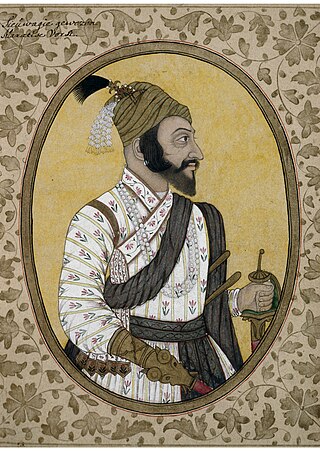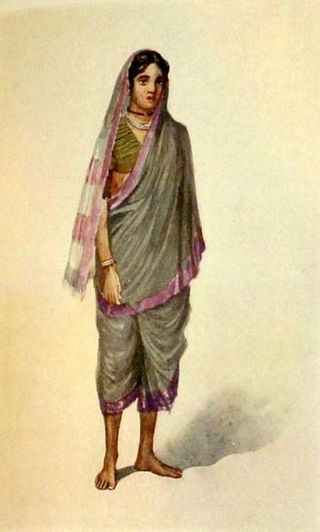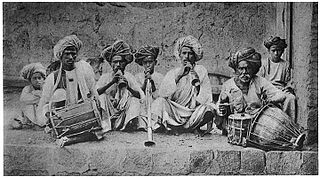Related Research Articles

Shivaji I was an Indian ruler and a member of the Bhonsle dynasty. Shivaji carved out his own independent kingdom from the Sultanate of Bijapur that formed the genesis of the Maratha Confederacy.

The Maratha Confederacy, also referred to as the Maratha Empire, was an early modern polity in the Indian subcontinent. It comprised the realms of the Peshwa and four major independent Maratha states often subordinate to the former. It was established in 1674 with the coronation of Shivaji as the Maratha Chhatrapati and recognised by Emperor Bahadur Shah I as a tributary state in 1707 following a prolonged rebellion. Following this, the Marathas continued to recognise the Mughal emperor as their nominal suzerain, similar to other contemporary Indian entities, though in practice, imperial politics at Delhi were largely influenced by the Marathas between 1737 and 1803.
The Maratha caste is composed of 96 clans, originally formed in the earlier centuries from the amalgamation of families from the peasant (Kunbi), shepherd (Dhangar), blacksmith (Lohar), pastoral (Gavli), carpenter (Sutar), Bhandari, Thakar and Koli castes in Maharashtra. Many of them took to military service in the 16th century for the Deccan sultanates or the Mughals. Later in the 17th and 18th centuries, they served in the armies of the Maratha Kingdom, founded by Shivaji, a Maratha Kunbi by caste. Many Marathas were granted hereditary fiefs by the Sultanates, and Mughals for their service.

Alandi is a town and a municipal council in the Pune district in the state of Maharashtra, India. The town is popular as a place of pilgrimage and for being the resting place of the 13th century Marathi saint Sant Dnyaneshwar.

Kunbi is a generic term applied to several castes of traditional farmers in Western India. These include the Dhonoje, Ghatole, Masaram, Hindre, Jadav, Jhare, Khaire, Lewa, Lonare and Tirole communities of Vidarbha. The communities are largely found in the state of Maharashtra but also exist in the states of Madhya Pradesh, Gujarat, Karnataka, Kerala and Goa. Kunbis are included among the Other Backward Classes (OBC) in Maharashtra.
Deshastha Brahmin is a Hindu Brahmin subcaste mainly from the Indian state of Maharashtra and North Karnataka. Other than these states, according to authors K. S. Singh, Gregory Naik and Pran Nath Chopra, Deshastha Brahmins are also concentrated in the states of Telangana (which was earlier part of Hyderabad State and Berar Division), Andhra Pradesh and Madhya Pradesh (Which was earlier part of Central Provinces and Berar) Historian Pran Nath Chopra and journalist Pritish Nandy say, "Most of the well-known saints from Maharashtra, Karnataka and Andhra Pradesh were Deshastha Brahmins". The mother tongue of Deshastha Brahmins is either Marathi, Kannada or Telugu.

Mahar is one of the dominant Indian caste found largely in the state of Maharashtra and neighbouring areas. Most of the Mahar community followed B. R. Ambedkar in converting to Buddhism in the middle of the 20th century. As of 2017 the Mahar caste was designated as a Scheduled Caste in 16 Indian states.

The Chitpavan Brahmin or the Kokanastha Brahmin is a Hindu Maharashtrian Brahmin community inhabiting Konkan, the coastal region of the state of Maharashtra. Initially working as messengers and spies in the late seventeenth century, the community came into prominence during the 18th century when the heirs of Peshwa from the Bhat family of Balaji Vishwanath became the de facto rulers of the Maratha empire. Until the 18th century, the Chitpavans were held in low esteem by the Deshastha, the older established Brahmin community of Karnataka-Maharashtra region.
The Dhangars are caste of people found in the Indian states of Maharashtra, northern Karnataka, Goa, Madhya Pradesh. They are referred to as Gavli Dhangars in northern Maharashtra and the forested hill tracts of India's Western Ghats, there are many distinct Gavli castes in Maharashtra and Dhangar Gavli is one of them.
Karhaḍe Brahmins are a Hindu Brahmin sub-caste mainly from the Indian state of Maharashtra, but are also distributed in states of Goa, Karnataka and Madhya Pradesh.

Pune district is a district in Western Maharashtra with Administrative Headquarters in Pune city. Pune district is the most populous district in the Indian state of Maharashtra. It is one of the most industrialised districts in India.
The Maratha Clan System refers to the 96 Maratha clans. The clans together form the Maratha caste of India. These Marathas primarily reside in the Indian state of Maharashtra, with smaller regional populations in other states.
The Nayak, or Naik is a historic honorific title conferred on military captains and governors of feudal states in the Middle Ages. Today it is also a surname. Nayaks are mostly Hindu and few Sikhs, who follow Hinduism and Sikhism respectively.

The Marathi people or Marathis are an Indo-Aryan ethnolinguistic group who are native to Maharashtra in western India. They natively speak Marathi, an Indo-Aryan language. Maharashtra was formed as a Marathi-speaking state of India on 1 May 1960, as part of a nationwide linguistic reorganisation of the Indian states. The term "Maratha" is generally used by historians to refer to all Marathi-speaking peoples, irrespective of their caste; However, it may refer to a Maharashtrian caste known as the Maratha which also includes farmer sub castes like the Kunbis.
Bhoite is a surname found amongst the Maratha caste, mainly in the state of Maharashtra in India but it also appears in Indian states bordering Maharashtra.

The Mali are an occupational caste found among the Hindus who traditionally worked as gardeners and florists. They also call themselves Phul Mali due to their occupation of growing flowers. The Mali are found throughout North India, East India as well as the Terai region of Nepal and Maharashtra. Iravati Karve, an anthropologist, showed how the Maratha caste was generated from Kunbis who simply started calling themselves "Maratha". She states that Maratha, Kunbi and Mali are the three main farming communities of Maharashtra – the difference being that the Marathas and Kunbis were "dry farmers" whereas the Mali farmed throughout the year.
Marathi Brahmins are communities native to the Indian state of Maharashtra. They are classified into mainly three sub-divisions based on their places of origin, "Desh", "Karad" and "Konkan". The Brahmin subcastes that come under Maharashtra Brahmins include Deshastha, Chitpavan (Konkanastha), Saraswat, Karhade, and Devrukhe.
Gavli is a Hindu caste in the Indian states of Maharashtra, Karnataka and Madhya Pradesh. They are a part of the Yadav community.

Maharashtra is a state in the western region of India. It is India's second-most populous state and third-largest state by area. The region that comprises the state has a long history dating back to approximately 1300–700 BCE, although the present-day state was not established until 1960 CE.

The Mang, or tang, community is an Indian caste mainly residing in the state of Maharashtra. Matang are known as Madiga "kommati" in Telangana, Andhra Pradesh and Karnataka.
References
- ↑ Pathak, Arunchandra S. (1976). Maharashtra State Gazetteers:Ahmednagar. Director of Government Printing, Stationery and Publications, Maharashtra State. p. 201,245.
- ↑ Thomas Edmund Farnsworth Wright; Oxford University Press (15 November 2006). A dictionary of world history. Oxford University Press. pp. 401–. ISBN 978-0-19-920247-8 . Retrieved 15 May 2011.
- ↑ K. S. Singh; Anthropological Survey of India (1998). India's Communities. Oxford University Press. p. 1903. ISBN 978-0-19-563354-2.
Kunbi[...]Bomle , Kadu , Wag , Baroda , Jane , Korde , Nikam , Dhole , Sete